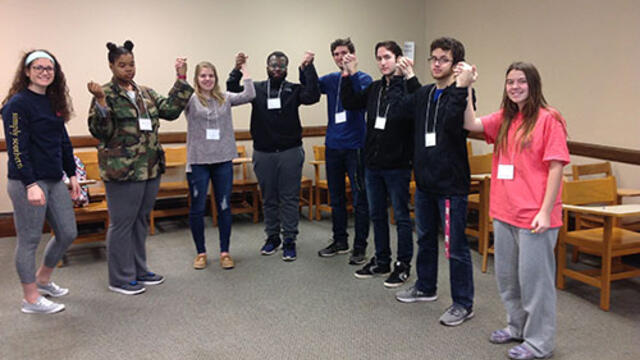Biology students link hands to form and better understand proteins

In what could have been a scene from the cult sci-fi films “Fantastic Voyage” and “Innerspace,” students in professor Cheng Huang’s Principles of Biology class studied proteins from the inside out.
Each taking on the identity and property of a different amino acid — the building blocks that are linked together in a protein — Huang’s first-year students used what they learned about amino acids to form human chains representing specific proteins.
“Since proteins are the molecules that perform the overwhelming majority of the tangible cellular functions in a living organism, understanding biology requires an understanding of how proteins work, and understanding how proteins work requires an understanding of protein structure,” Huang says, explaining that it is important that his students understand how the amino acids come together and how they bond chemically.
The Biology professor has turned the lesson into a contest with teams competing against each other or, as the case was this year, the class competing against the clock to arrange themselves in not only the correct order but the correct orientation to form specific proteins. The students prep by learning the properties of the 20 amino acids.
With amino acid name tags around their necks, the students are decorated with additional props such as rubber bands and colorful “atomic” beads to fulfill their amino acid identities. As they work to figure out the correct orientation to form new chemical bonds between each other — hand-holding — they incidentally synthesize the correct side-products: molecules of water made entirely of beads that used to be part of the amino acid.
Huang sets the terms of the competition by giving the students a coded order of the amino acids in the protein and they have to figure out which amino acid fits the property: “Methionine (the first amino acid) – the smallest amino acid – amino acid involved in cross linking – amino acid whose side chain is basic – amino acid with a ring structure – amino acid with a hydroxyl group – amino acid whose side chain is acidic.”
“Imagine that you zoom yourself down, and now you are part of a protein. You look around and see the structure and hold hands to form the bonds,” he says.
An “Innerspace” revival of sorts, except many times smaller, and a fun learning tool, the students say, that makes a complex topic easy to visualize, understand and remember. Working together, the class beat the clock two out of the three games to form the specified protein.
“I learned how important the specific order of amino acids are in a polypeptide (protein) chain,” says Caroline Ward, a first year students from Mt. Airy, Md. “Each amino acid’s chemical property plays a role in the function of the final peptide or protein.
“We all were able to work together and feed off of each other’s ideas.”
For Kendall Hanak, a first year student from Highlands Ranch, Colo., the game was a fun way to mix things up in class and trying to beat the clock appealed to her competitive nature.
“I am a very visual learner so I think that it made it easier to understand the dehydration aspect of joining peptide (protein) bonds, and it was nice to see it right in front of me,” she says.
In previous years, Huang divided the class into teams and pitted them against each other.
“The competition provided a more spatial and three-dimensional concept of polypeptides, instead of just drawing them out on paper,” says sophomore Biology major Jade Enright of Cresaptown, Md. “I think this was important to realize that it is actually relevant in the biological processes of the body, not just something that we needed to memorize.”
Apparently, once you’ve walked the walk of an amino acid and found your place in a protein, you aren’t likely to forget.
“The game allowed me not just to draw polypeptides (proteins) out or even think of them in my head, but apply what I knew to a totally novel problem, which was very rewarding,” says Cooper Hostetler, a sophomore Biology student from Cumberland, Md. “This connects to Dr. Huang’s core philosophy of true understanding and helped me to achieve that. To apply what I knew to a totally novel problem was very rewarding.
“The moment that a student is able to achieve clarity in their understanding by doing something outside of the box that is what will stick with them.”
Team captain Caroline Ward of Mt. Airy, Md., with her protein team of "amino acids," left to right, Catina Mable of Baltimore; Kendall Hanak of Highlands Ranch, Colo.; Michael Osei of Columbia, Md.; Matthew Ulrick of Owings, Md.; Johnny Schaeffer of Westminster, Md.; Drew Gardner of Dover, Del., and Madison Jamison of Davidsonville, Md.